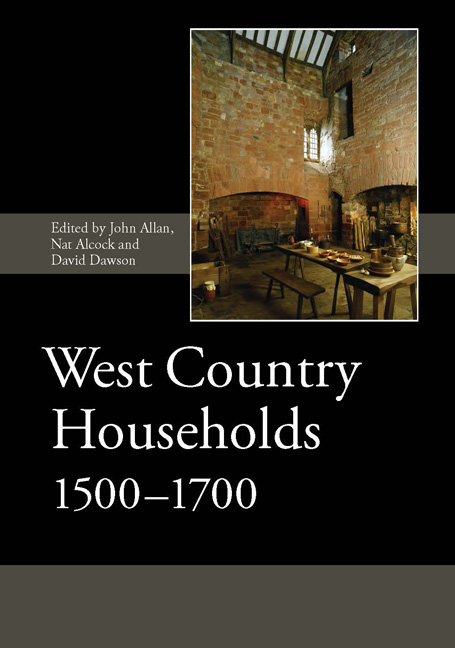Book contents
- Frontmatter
- Dedication
- Contents
- List of Illustrations
- List of Contributors
- List of Abbreviations
- Introduction
- I The Form and Development of West Country Houses
- II The Decoration of West Country Houses
- III The Material Culture of West Country Households
- 10 Culinary Artefacts in West Country Households, 1550–1700: Form, Function and Nomenclature
- 11 The Archaeology of the West Country Bronze Foundries
- 12 Cast Bronze Cooking Pots in England, 1500–1720
- 13 Table Glass in the West Country Home, c. 1500–1700
- 14 Portuguese Faience in South-West England
- 15 Dinner on the Ceiling: the 17th-Century Plasterwork at 144 Fore Street, Exeter
- 16 Pots and Texts: Understanding Pots in Use
- 17 Presenting an Elizabethan Interior: the Reinterpretation of St Nicholas Priory, Exeter
- Index of People and Places
- Index of Subjects
16 - Pots and Texts: Understanding Pots in Use
from III - The Material Culture of West Country Households
Published online by Cambridge University Press: 05 May 2015
- Frontmatter
- Dedication
- Contents
- List of Illustrations
- List of Contributors
- List of Abbreviations
- Introduction
- I The Form and Development of West Country Houses
- II The Decoration of West Country Houses
- III The Material Culture of West Country Households
- 10 Culinary Artefacts in West Country Households, 1550–1700: Form, Function and Nomenclature
- 11 The Archaeology of the West Country Bronze Foundries
- 12 Cast Bronze Cooking Pots in England, 1500–1720
- 13 Table Glass in the West Country Home, c. 1500–1700
- 14 Portuguese Faience in South-West England
- 15 Dinner on the Ceiling: the 17th-Century Plasterwork at 144 Fore Street, Exeter
- 16 Pots and Texts: Understanding Pots in Use
- 17 Presenting an Elizabethan Interior: the Reinterpretation of St Nicholas Priory, Exeter
- Index of People and Places
- Index of Subjects
Summary
For the historical archaeologist the presence of a documentary record is a major asset, but insufficient attention has been paid to the difficulty of bringing together artefacts and documentary sources. It is argued that an established classificatory language with only a loose relationship to period usage cannot be relied upon as a tool for interpretation. Evidence for the complexities of early modern word usage and the constant process of change in artefact function and language are discussed. A case study based on two large 17th-century groups of West Country ceramics illustrates the complexity of interpretation possible when documents, artefacts and illustrations are brought together.
INTRODUCTION
The relationship which exists between material culture and the language used to define and identify it is a much looser one than we sometimes acknowledge. We recognize that there are culturally defined subtleties within the language of material culture and that these can represent regional, generational, occupational and other constituencies. Changes in usage are commonplace but are often assigned to the errors of younger generations, or of Americans, rather than as part of an ongoing process. In dealing with the past, it is not unusual to come across references to an ‘original’ meaning, or reliance on the Oxford English Dictionary to provide the meaning of a word no longer current.
The mutability of language which we recognize in the present is part of an ongoing process which means that there are no ‘archaic terms’ which can be applied to translate – no original words which make everything clear and can be applied in every context. If, as historians of material culture and archaeologists, we are to make links between the document and the artefact, we need to recognize this and make allowance for it. In practice, material culture studies have suffered from over-emphasis on classification at the expense of interpretation. Associations between text and artefact are assumed, and language is often used uncritically without regard for the differences between period and modern usage.
- Type
- Chapter
- Information
- West Country Households, 1500–1700 , pp. 367 - 400Publisher: Boydell & BrewerPrint publication year: 2015



